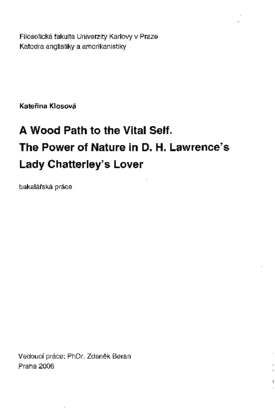A wood path to the vital self: the power of nature in D. H. Lawrence's Lady Chatterley's Lover
Lesní cestou k sebeoživení: síla přírody v D.H. Lawrencově Milenci lady Chatterleyové
bachelor thesis (DEFENDED)

View/
Permanent link
http://hdl.handle.net/20.500.11956/4401Identifiers
Study Information System: 26763
Collections
- Kvalifikační práce [23976]
Author
Advisor
Referee
Armand, Louis
Faculty / Institute
Faculty of Arts
Discipline
English and American Studies
Department
Information is unavailable
Date of defense
24. 5. 2006
Publisher
Univerzita Karlova, Filozofická fakultaLanguage
English
Grade
Very good
Jako vychozf text k teto bakalarske pn1ci poslouzil roman Milenec Lady Chatterleyove D. H. Lawrence. Pfi rozboru konkretnfch motivu v romanu bylo pouzito take nekolika Lawrencovych povfdek a eseju, ktere mely dale potvrdit autorUv trvaly zajem 0 dany okruh temat a jeho tendenci k jejich opakovane analyze, je.z se ve vetSine pffpadu lisf pouze danou situacf a protagonisty. Predmetem prace se stal predevsfm motiv probuzenf jedince k plnohodnotnemu citovemu zivotu a okolnosti, ktere Lawrence akcentuje pri uskutecnenf takove promeny, obzvlaste pak se specialnfm zamerenfm na ulohu lesa a roli prfrodnfch motivu v jeho due. Na zacatku je poukazano na vystavbu deje romanu zalozene na polarite, kontrastu jednotlivych lokalit, ktere jako by byly zosobneny ve dvou nejdulezitejsfch muzskych postavach romanu. Clifford, majitel panstvf Wragby, zastupuje pro Lawrence tak nenavideny, chladny, mechanicky prfstup k zivotu a k partnerskemu vztahu, ktery se dale projevuje take v jeho prfstupu k tavershallskym homfkum, pro nej pouze prostredkum k zfskanf financf. Naproti tomu Mellors, hajny zijfcf v le se obklopujfcf panstvf Wragby Hall, predstavuje .z:fvoucf element schopny cerpat energii z pffrody, u nehoz prirozeny instinkt ) nebyl jeste midobro znicen. Cliffordova mlada zena Connie, cfm dal vfce stradajfcf v prostredf, kde...
A wood in spring of such tender and perceptive description would certainly stir a living string not only in Connie Chatterley, the heroine of D. H. Lawrence's novel Lady Chatterley's Lover. The vividness and intensity of life that glares out of this 'picture' represents a dominant feature of Lawrence's novel which belongs to the last, fifth period of the author's career. It is not a mere coincidence that what later became published as Lady Chatterley's Lover was, in fact, a novel Lawrence originally proposed to call Tenderness. It is indeed sensibility of extraordinary degree, intense perception of colours, of slight movements and changes that occur in nature and the parallel changes taking place in the characters that play a vital role in this novel. This "extension of consciousness, [ ... ] an ability to experience what it is like to be a tree or a daisy or a breaking wave or what he (A. Huxley) called Lawrence's 'superior otherness",2 chiefly account for the poetic, soothing, almost pastoral character of Lady Chatterley's Lover. It seems to be in this novel that Lawrence's long-lasting belief in the revitalizing and revivifying power of nature, the idea of man's contact with and return to nature and the acceptance of his origins therein as the only means of survival for mankind come to their climax and...
